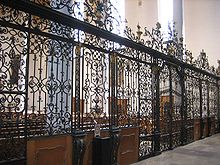Grid
A grid is an arrangement of elongated parts at regular intervals, which can be used to block off people, animals or foreign bodies. Two crossed layers of individual parts are often used. As a rule, a grid has a surrounding border. Metal is usually used as the material , but wood , stone or plastic are also used.
A horizontally lying grate is sometimes called a grate . In water management and industry, grids to keep out foreign bodies are often called rakes .

history
Manufacturing
The most common is the use of wrought or cast iron , in the Middle Ages also brass . The bars , strips or strips ( semi-finished products ) made of metal were held together at their cutting points by means of bundles or they were riveted . Great variety and skill was soon attained in the intertwining of these sticks . The smooth rods and ribbons were later adorned with forged ( fire-welded ) or cast leaves, flowers, arabesques , human and animal figures, also grotesques , so that the lattice finally became an important product of the handicraft and with the greatest luxury e.g. B. gildings were fitted.
Nowadays, for the production of grilles by artistic blacksmiths, in addition to the low-alloy structural steel , soft iron or pure iron and mainly in southern Germany, Switzerland and South Tyrol also the architectural bronze (wrought bronze), which is characterized by corrosion resistance and beautiful patina .
use
The blacksmiths made lattices to close chapels, in churches , to close the choir from the ships , to surround the grave monuments in the churches, to surround baptismal fonts , fountains and public monuments . In the Renaissance period , the grilles became general in private architecture and have remained so in the most varied of uses as gate, door, window, grave and garden grilles. Gold, copper, nickel, etc. are used to liven up the black iron color. In addition to the most common casting of grilles in the past, the art of blacksmithing has recently achieved great artistic success in the production of grilles.
A lead frame is a flat structure created by punching.
Examples
Characteristic examples are the Gothic lattice work on the so-called Quintin-Massys-Fountain in Antwerp , the lattice in the cathedral in Freising , the lattice on the tomb of Charles IV in the cathedral in Prague and the lattice at the Augustus fountain in Augsburg .
Securing means
In addition to being used as a decorative item, the grille is also used as an object of safety or security (see protective grille ). Barred windows and doors are in prisons and penal institutions to prevent attempts to escape and to secure the detainees. In other buildings (e.g. private houses), barred windows are installed as a security measure to protect against burglars ( burglary protection ). Grid fences are also raised in front of buildings that are worth protecting. Professionally correctly manufactured and permanently installed grilles achieve resistance class WK 6 as burglary protection . Scissor and rolling grilles, if installed accordingly, achieve resistance class WK 3 as burglary protection.
gallery
Window grilles in Iran
Trivia
In 1884 Camillo Sitte published an article "on the technology and training of the round iron grilles of the Renaissance".
See also
- architecture
- Others
swell
- Meyers Konversationslexikon, 1888
Web links
Individual evidence
- ↑ pure iron . Explanation of terms on the website of Angele Schmiedetechnik (longstanding and important mechanical engineering and forging supplier). Online at angele-shop.com. Retrieved March 3, 2013.
- ^ BauNetz Media GmbH: Structural bronze | Facade | Glossary | Baunetz_Wissen. Retrieved May 8, 2019 .
- ^ Camillo Sitte, Klaus Semsroth, Michael Mönninger, Christiane Crasemann Collins: Writings on art criticism and applied arts . Böhlau Verlag Wien, 2008, ISBN 978-3-205-77581-2 ( google.at [accessed April 7, 2019]).




